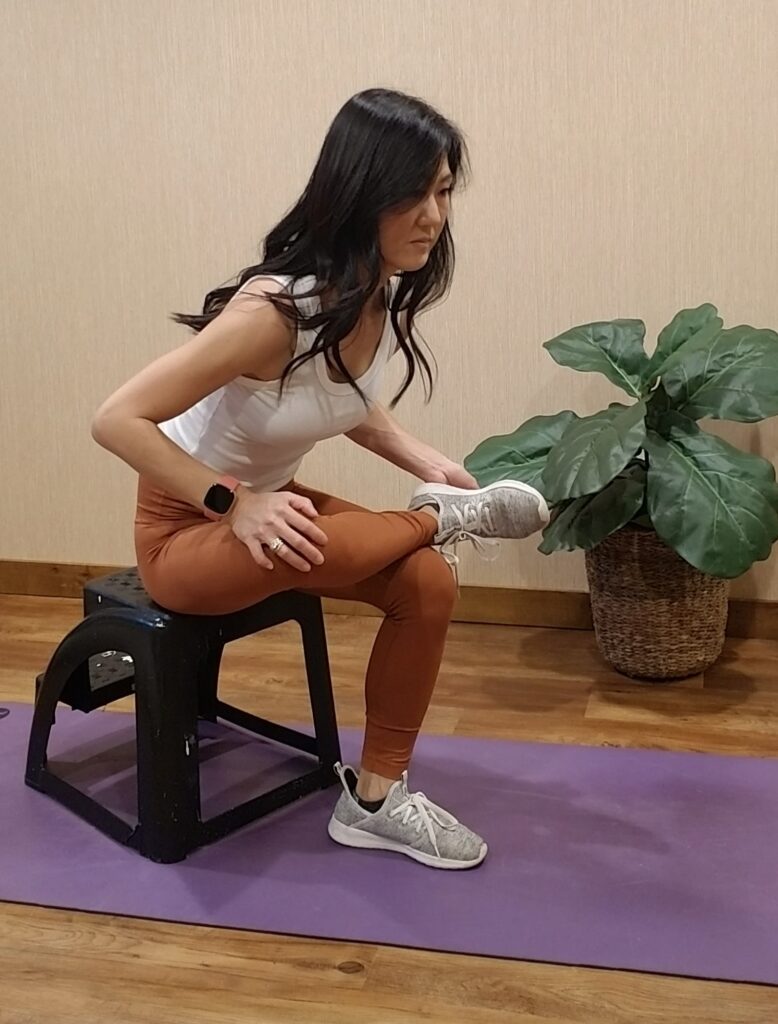5 Best Pregnancy Sciatica Stretches: Your Ultimate Guide to Relief
Last Updated on April 18, 2024 by Dr. Tiffany Egan
Pregnancy sciatica is a condition that I personally had trouble with and is also common among expectant mothers. It can cause debilitating pain and discomfort in the lower back, buttocks, and legs. Pregnancy sciatica stretches can help alleviate these issues and ensure a smoother pregnancy journey. “5 Best Pregnancy Sciatica Stretches: Your Ultimate Guide to Relief” provides valuable insights into understanding and managing sciatica during pregnancy, including safe and effective stretches like the hip flexor stretch. The guide focuses on safety precautions and tips to benefit both the mother and baby.

Table of Contents
Understanding Sciatica in Pregnancy
Understanding sciatica during pregnancy is crucial for managing discomfort effectively. This condition is caused from inflammation of the sciatic nerve—the longest and widest nerve in the body—which can manifest as pain, numbness, or tingling in the lower back, buttocks, and legs. Here’s a closer look at the factors contributing to this discomfort:
- Weight and Pressure Changes: As the baby grows, the increased weight exerts additional pressure on the sciatic nerve, often leading to sciatica symptoms.
- Postural Adjustments: Pregnancy alters a woman’s center of gravity. This shift can result in posture changes, placing strain on the lower back and potentially triggering sciatica.
- Hormonal Fluctuations: Hormones released during pregnancy, like relaxin, which helps prepare the body for childbirth, also loosen ligaments and joints. This loosening can destabilize the spine and pelvic area, exacerbating sciatic nerve pain.
These factors combine to make sciatica a common yet challenging issue for pregnant women, affecting their ability to perform daily tasks and maintain an active lifestyle. Understanding these causes helps in finding appropriate treatments and preventive measures to alleviate pain and improve quality of life during pregnancy.

Benefits of Stretching for Sciatica Relief
Engaging in regular pregnancy sciatica stretches offers numerous benefits that can significantly enhance comfort and mobility for expectant mothers suffering from sciatic nerve pain. Here’s how these stretches can make a positive difference:
- Alleviation of Pain and Inflammation: Stretching helps to ease the discomfort associated with sciatica by reducing inflammation around the sciatic nerve. This relief of pressure and inflammation can decrease the sharp, shooting pain often experienced in the lower back and legs.
- Improved Circulation and Muscle Tension Relief: Proper stretching techniques increase blood flow, which aids in healing and provides essential nutrients to the affected areas. Additionally, it helps relax tight muscles, further relieving pain and preventing muscle spasms that contribute to discomfort.
- Enhanced Posture and Muscle Strength: Stretching strengthens the muscles in the back and abdomen, which are crucial for supporting the spine. This increased muscle strength can improve posture, which is often compromised during pregnancy due to the extra weight. Better posture reduces the strain on the sciatic nerve and helps prevent further pain episodes.
By incorporating targeted stretches into your daily routine, you can enjoy these benefits, leading to a more comfortable and active pregnancy. This proactive approach not only helps manage current sciatic pain but also contributes to overall body wellness, preparing the body better for the demands of childbirth.

Preparation for Sciatica Stretching
Before embarking on pregnancy sciatica stretches, it is essential to prepare adequately to ensure both the safety and effectiveness of your stretching routine. Here are some key considerations:
- Listen to Your Body:
- Always be attentive to how your body feels during stretching. If you experience any pain or discomfort, it is crucial to stop immediately to prevent any potential harm.
- Adopt Proper Stretching Techniques:
- Move Slowly and Gently: Avoid any sudden or jerky movements. Gradual motions help maintain control and prevent strain.
- Deep Breathing: Focus on breathing deeply and evenly throughout your stretches. This helps in relaxing the muscles and increasing oxygen flow to the tissues.
- Avoid Overstretching: Be cautious not to overextend yourself, especially around the joints. This is particularly important due to the hormonal changes during pregnancy, which can loosen ligaments and increase the risk of injury.
By following these guidelines, you can maximize the benefits of your stretching routine while minimizing the risk of aggravating your sciatica or causing injury. These steps serve as a foundation for a safe and effective approach to managing pregnancy-related sciatica discomfort.
5 Effective Pregnancy Sciatica Stretches
5 Effective Pregnancy Sciatica Stretches
To alleviate discomfort from sciatica during pregnancy, consider incorporating these effective stretches into your routine. Each stretch targets areas commonly affected by sciatica, helping to reduce pain and improve flexibility.

- Pigeon Pose:
- Cross your right leg over your left so that your right ankle rests on your left knee.
- Gently lower your body toward the floor, keeping your back straight to avoid strain.
- Hold this position for 30 seconds, then switch to the other side.
- This pose helps relieve sciatica by stretching the lower back and glutes.
- Gluteal Stretch:
- Lie on your back with knees bent and place your right ankle on your left knee.
- Gently press your right knee away from your body, holding the stretch for 30 seconds.
- Keep your back flat and shoulders relaxed. Switch sides and repeat.
- Effective for easing sciatic pain by relaxing the gluteal muscles.
- Table Stretch:
- Stand facing a table, feet hip-width apart.
- Lean forward, placing your hands on the table, keeping arms straight and back flat.
- Gently pull your hips away from the table until you feel a stretch. Hold for a few deep breaths and sway hips side to side for additional relief.
- Garland Pose (Squat Pose):
- Begin in a squat with feet close together, keeping heels on the floor.
- Use your elbows to press your inner knees outward while lowering your body.
- Hold this pose for 30 seconds to stretch the lower back and hips, areas often affected by sciatica.
- Child’s Pose: One of my personal favorites!
- Kneel and slowly lower your body to the floor, spreading your knees wide enough to accommodate your belly.
- Extend your arms forward, rest your forehead on the floor, and hold for 30 seconds.
- This relaxing pose stretches the spine and relieves tension in the back.

Each of these stretches provides targeted relief for sciatica symptoms in pregnancy, promoting overall comfort and mobility.
Safety Precautions and Tips
When engaging in pregnancy sciatica stretches, it’s crucial to prioritize safety to prevent exacerbating discomfort or causing injury. Here are essential precautions and tips to ensure a safe stretching routine:
- Again… Listening to Your Body: Always stop immediately if you experience any pain or discomfort. This is your body’s way of signaling that something might be wrong.
- Proper Stretching Technique:
- Ensure that you stretch gently and avoid overstretching muscles, which can lead to strains or injuries.
- Keep your spine straight to prevent unnecessary pressure on your back.
- Move slowly and avoid any jerky or sudden movements to maintain control and prevent harm.
- Breathing and Pressure:
- Breathe deeply and evenly throughout your stretches to help oxygenate your muscles and promote relaxation.
- Avoid placing excessive pressure on your joints, which are more susceptible to injury during pregnancy due to hormonal changes that loosen ligaments.
If severe pain occurs, it is crucial to consult with a healthcare provider to ensure that your exercise regimen is appropriate and safe for your specific pregnancy needs. Always remember that each pregnancy is unique, and what works for one individual may not be suitable for another.

Conclusion
This guide provides vital information on specific pregnancy sciatica stretches to alleviate discomfort. It explores the causes of pregnancy sciatica, the benefits of stretching, and a safe approach to integrating exercises into daily routines. By understanding the factors behind sciatica pain and adopting suggested stretches, expectant mothers can experience maximum comfort and mobility during pregnancy!
FAQs
1. What are some methods to alleviate sciatic nerve pain during pregnancy?
To help ease sciatic nerve discomfort during pregnancy, consider laying on the side that doesn’t hurt to lessen pressure on the sciatic nerve. Avoid standing for extended periods and try to incorporate swimming into your routine, as it can provide relief. Warm showers, Epsom salt baths or warm compresses can also be soothing, and make sure to avoid lifting heavy items.
2. Is it advisable to walk if I’m experiencing sciatica during pregnancy?
Walking for long stretches might not be beneficial if you are experiencing sciatica during pregnancy. If standing is necessary, try resting the foot on the painful side on a stool or similar object to alleviate some of the discomfort. Also, avoid sitting in one position for too long.
3. Why is my sciatic nerve pain so intense during pregnancy that it prevents me from walking?
Sciatica can be particularly painful and may require significant rest to heal. While some discomfort is common, experiencing severe pain is not typical. If you encounter excruciating pain, certain over-the-counter medications might offer relief, but it’s crucial to consult your doctor before taking any medication to ensure it is safe for your baby.
4. How can I quickly relieve sciatica pain?
For prompt relief from sciatica, you can apply a heating pad or ice pack to the affected areas. Building core strength, staying active, and lifting objects correctly by using your legs can also help. Pay attention to what triggers your pain and try to avoid those activities. Maintaining a healthy weight, ensuring proper posture, and stretching your lower back and hamstrings are additional ways to manage sciatica symptoms.







